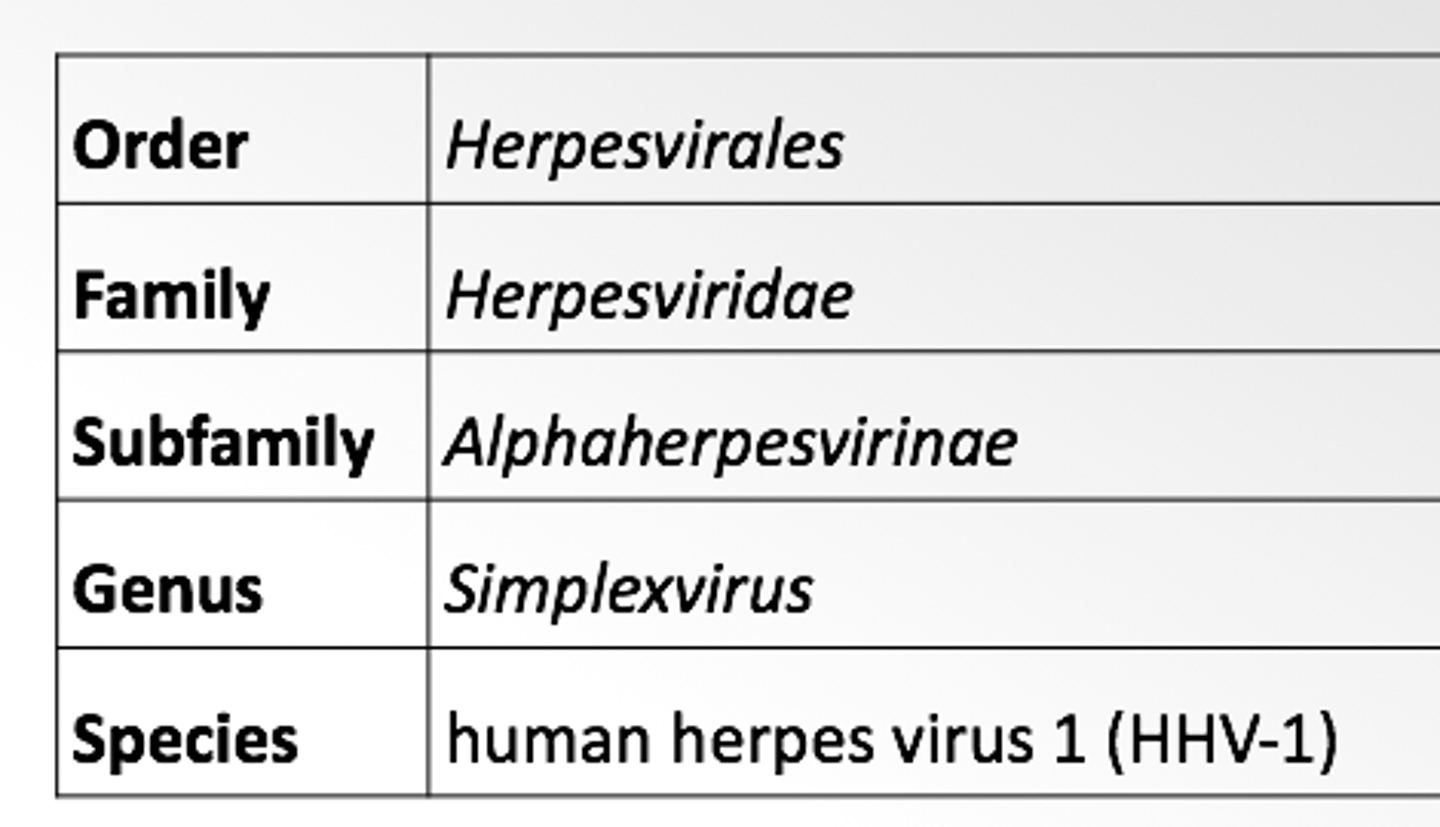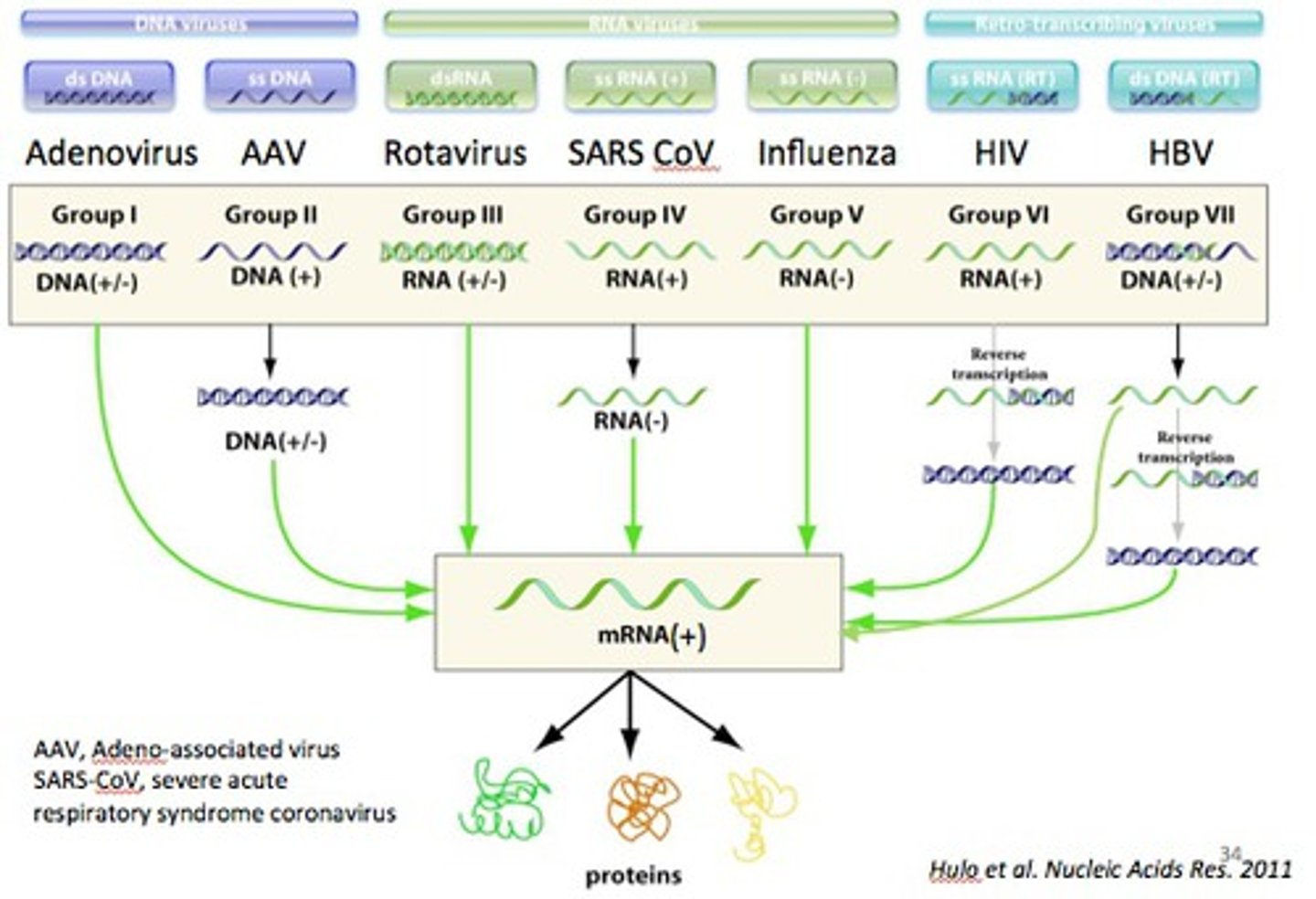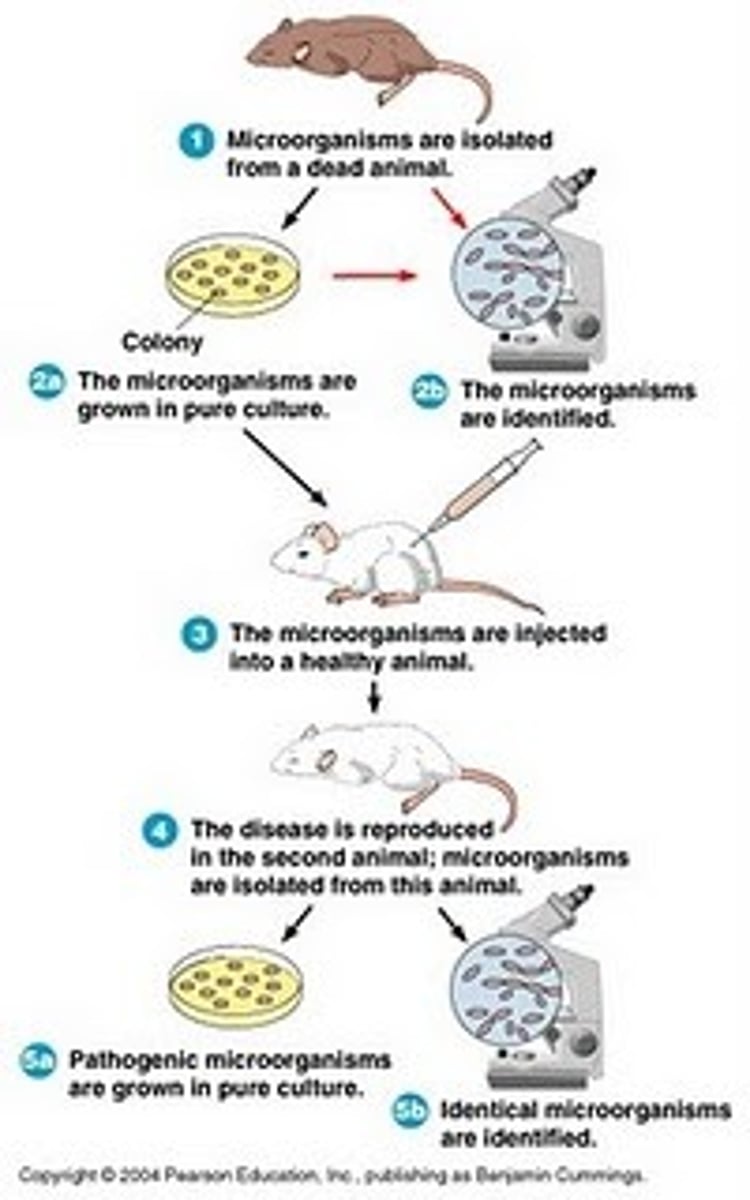Unit 3 exam review !!!!! (yes)
1/394
There's no tags or description
Looks like no tags are added yet.
Name | Mastery | Learn | Test | Matching | Spaced |
|---|
No study sessions yet.
395 Terms
Virus Features
- Obligatory intracellular parasites (need living cell to multiply)
- Contain DNA or RNA
- Contains protein coat
- Multiply within living host cell (via host cell synthesizing machine)
- no ribosomes
- no ATP-generating mechanism
What is Host Range?
The spectrum of host cells a virus can infect
- most viruses infect only specific types of cells in one host
(Bacteriophages phage receptor either part of bacterial cell wall, fimbriae, or flagella)
(Animal viruses receptor sites are usually on the plasma membrane)
Viral Structure
Virion - complete, fully developed viral particle
- Nucleic Acid: DNA or RNA can be single- or double stranded; linear or circular
- Capsid: Protein coat made of capsomeres (subunits)
- Envelope: Lipid, protein, and carbohydrate coating on some viruses
- Spikes: Projections from outer surface
Nucleic Acid in relation to viruses
- Viral genome is DNA or RNA, never both
- Viral genome may be single-stranded or double-stranded
- Nucleic acid may be linear or circular or segmented
- Total lamount of nucleic acid varies
- From a few thousand nucleotides to as many as 250,000 nucleotides
Capsid and Envelope
Capsid: has a protein coat and is made up of capsomeres (protein subunits)
Envelope: Present in some viruses, external to the capsid
- Composed of lipid, protein, and carbohydrate
- Partially formed from the plasma membrane of the host cell
- Forms when the virus buds from the cell
Spikes: surface carbohydrates and/or proteins
- found on some enveloped viruses
- may be used for attachment
General Morphology
Helical Viruses: Hollow cylindrical capsid that is helical
(ex: viruses that cause rabies/ebola virus)
Polyhedral Viruses (Many-sided): Most are an icosahedron (20 triangular facets and 12 corners)
(ex: adenoviruses and poliovirus)
Enveloped Viruses: most are roughly spherical
Complex Viruses (Complicated Structures)
Example: bacteriophage
Taxonomy of Viruses
Seven groups referred to as "realms"
Genus names end in -virus
Family names end in -viridae
Order names end in -ales
Viral Species: a group of viruses sharing the same genetic information and ecological niche (host)

Baltimore classification system
Distinguished by genome composition and mRNA route
Group I: Double-stranded DNA viruses
Group II: Single-stranded DNA viruses
Group III: Double-stranded RNA viruses
Group IV: (+) sense single-stranded RNA viruses
Group V: (-) sense single-stranded RNA viruses
Group VI: Retroviruses (RNA reverse-transcribing viruses)
Group VII: Pararetroviruses (DNA reverse-transcribing viruses)

Growing bacteriophages in lab
-viruses must be grown in living cells
-bacteriophages are grown in bacteria
- Which are clearings on a lawn of bacteria on the surface of agar
- Each plaque corresponds to a single virus
- Can be expressed as plaque-forming units (PFU)
Growing animal viruses in laboratory
in living animals: mice/rabbits/guinea pigs, some cannot human viruses cannot be grown in animals or can be grown but not cause disease in animal
in embryonated eggs: virus injected into egg, viral growth is signaled by changes or death of embryo, used to grow viruses for some vaccines
In cell cultures - primary cell lines:
-Tissues are treated with enzymes to separate cells
-Cells suspended in a nutrient solution in a tube or special flask—referred to as a primary cell line
-Cells will adhere to container and reproduce to form a monolayer
-Viruses infecting the monolayer are detected via the visible changes or deterioration of the monolayer cells, known as the cytopathic effect (CPE)
-Primary cell lines tend to die out after a few generations; require a continuous source of cells
cell structures for growing animal viruses
cell cultures: may use diploid cell lines derived from human embryos (maintained for about 100 generations)
continuous cell lines: derived from transformed (cancerous) cells
can be maintained indefinitely via HeLa cell line
Viral Identification
Cytopathic effects observed on cell culture
Serological tests: ELISA - virus is detected and identified by its reaction with antibodies
Nucleic acids: PCR
How does a virus multiply?
It must invade a host cell and take over the host's metabolic machinery
A single virion can form tens to thousands of viruses in a host cell
One step growth curve
Lytic Cycle (Multiplication of Bacteriophages)
Phage causes lysis and death of the host cell
ex: tequatrovirus (T-even bacteriophages) that infect E. coli
Lysogenic cycle
phage DNA is incorporated in the host DNA
Phage conversion
Specialized transduction
T-Even (Tequatrovirus) Bacteriophages: Lytic Cycle
Attachment: Phage attaches by the tail fibers to the host cell
Penetration: phage lysozyme opens the cell wall
- Tail sheath contracts to force tail core and DNA into cell
Biosynthesis: production of phage DNA and proteins
- Host cell protein synthesis is halted
Maturation/Assembly:
Assembly of phage particles
Release: Phage lysozyme breaks the cell wall
Lambda Phage Lysogenic Cycle
Not all phages complete the lytic cycle
Temperate Phages (ex. Lambda phage)
- adsorb and penetrate but not induce expression
The viral genome inserts into bacterial genome: becomes an inactive prophage - the cell is not lysed
Prophage is retained and copied during normal cell division - Resulting in the transfer of phage genome to all host cell progeny
Induction can occur resulting in activation of lytic cycle
Induction
Typically triggered by host cell stress
- activates DNA recombinase to cut the prophage out of the genome and initiate the lytic phase
- followed by viral replication and cell lysis
Lysogenic Cycle characteristics
Lysogenic host cells are immune to reinfection by the same phage
Phage conversion: host cell exhibits new properties (encoded by prophage DNA)
Ex: production of diphtheria toxin by Corynebacterium diphtheriae
specialized transduction
- Bacterial genes transferred to another bacterium via a phage
- Changes genetic properties of the recipient bacteria
Multiplication of Animal Viruses
attachment, penetration/genome entry, uncoating, synthesis and assembly, exit and transmission/release
Attachment (adsorption)
Binding of virus to specific molecules on the host cell
Genome entry/Penetration
Viral genome enters the host cell
- Occasionally in an endosome
Uncoating
Viral genome is released from the capsid
Synthesis and Assembly
- Viral components are produced
- New viral particles are constructed
Exit and Transmission/Release
Assembled viruses are released
- By budding (enveloped viruses) or cell lysis (naked viruses)
Biosynthesis of DNA viruses
- Replicate their DNA in the host nucleus, using host enzymes
- Synthesize Capsid proteins in the cytoplasm using host cell enzymes
- Capsid proteins migrate into nucleus where assembly occurs
Adenoviridae
Double-stranded DNA, nonenveloped
Respiratory infections in humans
Tumors in animals
Poxviridae
• Double-stranded DNA, enveloped
• Cause skin lesions (smallpox/MPOX virus)
• Assembly occurs in the cytoplasm
Herpesviridae
Double-stranded DNA, enveloped
HHV-1 and HHV-2—Simplexvirus; cause cold sores
HHV-3—Varicellovirus; causes chickenpox
HHV-4—Lymphocryptovirus; causes mononucleosis
HHV-5—Cytomegalovirus
HHV-6 and HHV-7—Roseolovirus
HHV-8—Rhadinovirus; causes Kaposi's sarcoma
Papovaviricetes
Double-stranded DNA, nonenveloped
Alphapapillomavirus: causes warts, some species can transform cells and cause cancer
Hepadnaviridae
Double-stranded DNA, enveloped
Hepatitis B virus
Use reverse transcriptase to make DNA from RNA
Where do viruses multiply?
in the host cell's cytoplasm via RNA-dependent RNA polymerase
+ strand ssRNA (sense strand)
Viral RNA serves as mRNA for protein synthesis
- Strand ssRNA (antisense strand)
Viral RNA is used as a template for mRNA synthesis
- Requires RNA dependent RNA polymerase provided by virus and packed into virions
dsRNA
- double-stranded RNA
Biosynthesis of RNA viruses
Coronaviridae, Togaviridae, Rhabdoviridae, Picornaviridae, Reoviridae
Coronaviridae
Include SARS-CoV-2 which causes COVID-19 (as well as 4 species that cause mild respiratory infections)
- single-stranded RNA, + strand, enveloped
- Assembly involves the ER and Golgi of the host cell
Togaviridae
- Single-stranded RNA, + strand, enveloped
- alphavirus
- transmitted by arthropods; includes the virus that causes eastern equine encephalitis
Rhabdoviridae
- strand single-stranded RNA
- Lyssavirus - rabies
- Numerous animal diseases
Picornaviridae
+ strand single-stranded RNA, nonenveloped
- Enterovirus - poliovirus and coxsackievirus
- Rhinovirus - common cold
Hepatitis A virus
Reoviridae
Double-strande RNA, nonenveloped
- Reovirus (respiratory enteric orphan)
- Rotavirus (mild respiratory infections and gastroenteritis)
Retroviruses
single stranded RNA, produce DNA
- uses reverse transcriptase to produce DNA from the viral RNA genome
- Viral DNA integrates into host chromosome as a provirus (protected from host's immune system and antiviral drugs)
Retroviridae: Lentivirus (includes HIV), oncoviruses
Viruses and Cancer
Several types of cancers are caused by viruses
- may develop long after a viral infection
- Cancers caused by viruses are not contagious
Sarcoma
cancer of connective tissue
Adenocarcinomas
Cancers of glandular epithelial tissue
oncolytic viruses
infect and kill tumor cells or cause an immune response against tumor cells
(currently being modified and tested as a cancer treatment, some currently in use).
Proto-oncogenes (transformation of normal cells into tumor cells)
genes that encode proteins involved in stimulating normal cell growth
- mutated proto-oncogenes become oncogenes
Oncogenes
genes that transform normal cells into cancerous cells
Transformation
Cells require distinct properties leading to cancer
Oncogenic viruses integrate into the host cell's DNA and induce tumors
DNA oncogenic viruses
• Adenoviridae
• Herpesviridae
Epstein-Barr virus
• Poxviridae
• Papovaviridae
Human papillomavirus
• Hepadnaviridae
Hepatitis B virus
• Retroviridae - HTLV-1/HTLV-2 cause adult T cell leukemia and lymphoma
FelV: feline leukemia virus
Latent virus
- remains in asymptomatic host cell for long periods
- All herpesviruses are capable of latency
- May reactivate due to changes in immunity
- HHV1: cold sores
- Varicellovirus: shingles
persistent viral infection
- occurs gradually over a long period
- is generally fatal
- subacute sclerosing panencephalitis (measles virus)
Plant viruses
- Enter through wounds or via insects
- Plant cells are generally protected from disease by an impermeable cell wall
- Viruses enter via wounds or damage from parasites
- Cause many diseases in economically valuable plants
Plant viroids
short pieces of naked RNA
- cause potato spindle tuber disease
Plant Virusoids
viroids enclosed in a protein coat
- cause disease when plant cell is coinfected with a virus
Prions
Proteinaceous infection particles (PRION = PRotein infectION)
inherited and transmissible through ingestion, tranasplant, wounds
types of prion diseases
Spongiform encephalopathies (neurodegenerative diseases)
- Gerstmann-Straussler-Scheinker syndrome
- Creutzfeldt-Jacob disease (CJD)
- "Mad cow disease"
- Fatal familial insomnia
- sheep scrapie
Types of prions
PrPC: normal cellular prion protein, on cell surface
PrPSc: scrapie protein; accumulates in brain cells, forming plaques
Disease caused by protein misfolding
- conversion of host PrPC into misfolded PrpSC
Pathology
The study of disease
Etiology
The cause of a disease
Pathogenesis
the manner in which a disease develops
Infection
Invasion or colonization of the body by pathogens
Infectious disease
- occurs when an infection results in any change in the state of health
- an infection amy exist in the absence of a detectable disease
- disease may result when a microorganism locates in an area where it is not normally found
Human microbiome
-begins to establish in utero
-more microorganisms acquired from food, people, and pets
-remain throughout life
- estimated to be about 40.000.000.000.000 bacterial cells (10x more than the number of human cells in body)
Human Microbiome Project (HMP)
analyzes relationships between microbial communities on the body and human health
Normal microbiota (normal flora)
permanently colonize the host and do not cause disease under normal conditions
transient microbiota
may be present for days, weeks, or months and then disappear
what is the human microbiome dependent on?
nutrients, physical and chemical factors, mechanical factors, body's defenses against microbes, age/diet/hygiene/lifestyle
plays role in immune system development
vaginal birth
prevalently Lactobacillus and Bacteroides
Cesarean Birth
Microbiome resembles human skin and staphylococcus aureus present
What is Microbial antagonism? (competitive exclusion)
competition between microbes
How does normal microbiota protect the host?
Competing for nutrients
Producing substances harmful to invading microbes
Affecting pH and available oxygen
Clostridium difficle can cause severe intestinal infections if...
normal biota are reduced by antibiotic treatment
replacing normal microbiota can trat C. difficile infections (now done using fecal microbial transfer FMT)
Symbiosis
A close relationship between two species that benefits at least one of the species.
Commensalism
one organism benefits and the other is unaffected
Mutualism
both organisms benefit
Parasitism
One organism benefits at the cost of the other
Robert Koch Experiment
- Obtained Anthrax from affected cow corpse
- Incoulated rabbit with infected blood, killing rabbit
- inoculated second rabbit with blood from first rabbit, killing the second rabbit
- identified long rod-shaped bacilli in blood samples
Koch's Postulates
- The microbe is found in all cases of the disease
- The microbe is isolated from the diseased host and grown in pure culture
- Introducing the microbe into a healthy susceptible host, causes the disease
- The same strain of microbe is obtained from the newly diseased host

Exceptions to Koch's Postulates
1. Some pathogens can cause several disease conditions
2. Some pathogens cause disease only in humans
3. Some microbes have never been cultured
4. Several different pathogens may cause the same signs and symptoms
Symptoms (infectious disease classification)
- subjective changes in body function felt by patient as result of disease
- not apparent to observer
Signs (infectious disease classification)
objective changes in body that can be measured or observed
syndrome
a specific group of signs and symptoms that accompany a disease
communicable disease
a disease spread from one host to another
(ex: covid-19, chicken pox, measles, infleunza, genital herpes, tuberculosis)
contagious disease
a disease that can easily and rapidly spread from one host to another
noncommunicable disease
A disease that is not spread from one host to another
(ex: tetanus)
Incidence
number of people who develop a disease during a paticular time period
Prevalence
number of people who have a disease at a specified time (regardless of when it first appeared), takes into account both old and new cases
sporadic disease
disease that occurs only occasionally
endemic disease
disease constantly present in a population
epidemic disease
disease acquired by many people in a given area in a short time
pandemic disease
worldwide epidemic
Duration
average time that individuals have a disease from diagnosis until either cured or dead
acute disease
symptoms develop rapidly but has a short duration
chronic disease
symptoms develop slowly, likely to last for a long period
subacute disease
intermediate between acute and chronic
latent disease
causative agent is inactive for a time but then activates and produces symptoms
severity
the presence and extensiveness of a disease in the body and its ability to cause death